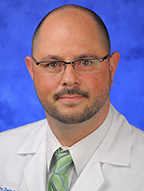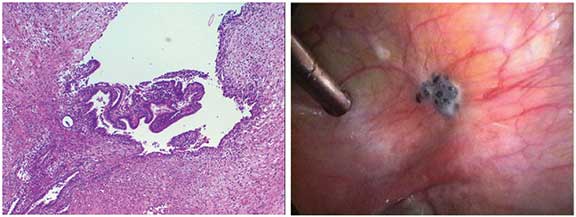Endometriosis Tissue Bank to Identify Key Biomarkers for the Disease
Timothy Deimling, M.D., Obstetrics and Gynecology, is in the final stages of obtaining institutional review board approval to launch a prospective database and tissue bank for endometriosis research. The primary purpose is to identify biomarkers for less invasive diagnosis, in addition to identifying targets for treatment of endometriosis. “Most women with pelvic pain and infertility obtain definitive diagnosis of endometriosis after a long history of problems; the delay in diagnosis is in large part due to the fact that it requires surgery,” notes Dr. Deimling. The tissue bank is being established according to guidelines set by the supporting World Endometriosis Research Foundation (WERF), and is planned to include multiple centers in the U.S. and internationally.
Dr. Deimling, who is also partnering with the Institute for Personalized Medicine for this project, says, “Patients with a confirmed diagnosis of endometriosis who consent will provide tissue, blood and fluid samples. In addition, a large amount of clinical, personal and family medical history information will be requested, such as menstrual and reproductive history, comorbidities and quality-of-life. We’re being very careful in developing this protocol, to gather the right pieces of information to maximize the value of the research.” The Institute for Personalized Medicine uses a multifaceted approach toward translational research and pharmacogenomics, with the downstream goal of tailoring health care to individual patients to improve medical outcomes.
Endometriosis is present when endometrial tissue located outside the uterus grows and bleeds in sync with a woman’s menstrual cycle. Located most often in the ovaries, bowel or pelvic tissues, the tissue causes pain, abnormal bleeding and eventual formation of adhesions and scar tissue. Unfortunately, at this point, very little is known about what causes endometriosis to develop and persist. Dr. Deimling adds, “One hypothesized cause of endometriosis is retrograde menstruation, wherein menstrual blood and tissue moves up into the fallopian tubes toward the ovaries, depositing endometrial cells that eventually implant and grow in the new extra-uterine location.”
Endometriosis occurs in approximately 6 to 10 percent of adult women; among the subset of women with pelvic pain and infertility, the prevalence of endometriosis jumps to 40 to 50 percent. Endometriosis is a complex disease that seems to be part of a syndrome or cluster of illnesses; it often occurs in association with chronic pain, interstitial cystitis, ovarian cancer and irritable bowel syndrome. One to 3 percent of patients with endometriosis undergo colorectal surgery for resection of endometrial growths. Dr. Deimling notes, “Endometriosis and the other illnesses it is commonly seen with are all marked by inflammation and aberrant immunological responses. These common mechanisms may provide some clues about potential biomarkers that might be used for diagnosis from a blood test or tissue sample rather than surgery, as well as identification of potential treatment targets.”
Current treatment options for endometriosis include hormonal therapy, surgical removal of ectopic endometriotic lesions, or a combination hormone and surgery approach. Hormonal therapy may consist of estrogen and progesterone, progestin-only products typically used for birth control, or alternatively, a gonadotropin releasing hormone analogue, such as leuprorelin acetate combined with progestin. According to one recent randomized trial in women ages 18 to 44 years¹, cure rates, based on clinical patient reports of symptoms and pain, appear to be similar with all three approaches, ranging from 50 percent with surgical treatment alone to 60 percent with combined hormonal and surgical treatment.
A major limitation of endometriosis research has been the small and very select nature of patient populations studied. The tissue bank project led by Dr. Deimling at Penn State Health Milton S. Hershey Medical center is primarily focused on overcoming such limitations through global collaboration, eventually gathering a large number of patients’ tissue samples and related personal and medical data from centers all over the world. A secondary, but important component of the tissue bank and other efforts supported by WERF, is the Endometriosis Phenome and Biobanking Harmonisation Project (EPHect). Penn State Health-based endometriosis tissue bank protocol is being developed in line with WERF EPHect guidelines for endometriosis harmonization.2-5 The main EPHect project goal is to enhance worldwide collaboration, to affect more rapid research progress in the realm of endometriosis through standardization of clinical and research language and more consistent use of the same measurement devices to assess diagnostic and treatment outcomes.
 Timothy Allen Deimling, M.D., MS
Timothy Allen Deimling, M.D., MS
Assistant Professor of Obstetrics and Gynecology
Assistant Program Director, Fellowship in Minimally Invasive Gynecology Surgery
PHONE: 717-531-6447, Option 5
E-MAIL: tdeimling@hmc.psu.edu
RESIDENCY: Obstetrics and gynecology, Penn State Health Milton S. Hershey Medical Center, Hershey, Pa.
MEDICAL SCHOOL: Penn State College of Medicine, Hershey, Pa.
Connect with Timothy Deimling, M.D. on Doximity
REFERENCES:
- Mettler L, Ruprai R, Alkatout I. 2014. Impact of medical and surgical treatment of endometriosis on the cure of endometriosis and pain. Biomed Res Int. 2014;2014:264653.
- Becker CM, et al. 2014. World Endometriosis Research Foundation Endometriosis Phenome and Biobanking Harmonisation Project: I. Surgical phenotype data collection in endometriosis research. Fertil Steril 102(5):1213-1222.
- Vitonis AF, et al. 2014. World Endometriosis Research Foundation (WERF) Endometriosis Phenome and biobanking harmonization project (EPHect): II. Clinical and covariate phenotype data collection in endometriosis research. Fertil Steril 102(5):1223-1232.
- Rahmioglu N, et al. 2014. WERF Endometriosis Phenome and Biobanking Harmonization Project (EPHect): III. Fluid biospecimen collection, processing, and storage in endometriosis research. Fertil Steril 102(5):1233-1243.
- Fassbender A, et al. 2014. World Endometriosis Research Foundation Endometriosis Phenome and Biobanking Harmonisation Project (EPHect): IV. Tissue collection, processing, and storage in endometriosis research. Fertil Steril 102(5):1244-1253.

